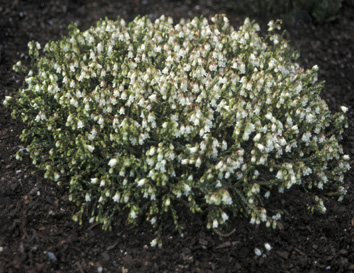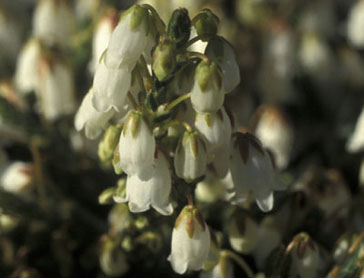| When
Pat and I constructed our first raised bed I kept one part for ericaceous
plants, and fortunately this was in a part of the garden facing northwest
and close to a hedge, so that although it gets plenty of light it does not
get full sun all day. This was not great foresight on my part, but rather
the happy coincidence of getting the right plants and the right conditions
together, for Cassiopes and other ericaceous plants have done well in it.
It
is of course possible to grow Cassiopes in pots, and indeed raise them to
top show standards, but that requires much more attention to watering. |
| In
a raised bed I only begin to worry after a rainless spell of two to three
weeks, and start to reach for the sprinkler or hose. When, as is often the
case here, the rain never ceases and I start to despair of my other
alpines, I can at least rest assured that my Cassiopes are loving it. The
bed is never covered, winter or summer, and the only attention
"Kathleen Dryden" gets is a good haircut after flowering in
April, and a working in of mulch into the entire rosette. This encourages
new growth and the browning of the stems, particularly as the plant gets
older is minimized. If desired a plant can be lifted and potted for shows,
taking care not to crowd the roots into too small a pot. I have not
noticed any detriment when replanted. After about eight years of steady
growth in good conditions it can reach 36cm in diameter. The plants in the
bed get an occasional ericaceous feed, and the whole bed is topped up if
the level falls (as it slowly will). |
| What is known of the origin of "Kathleen
Dryden" is that it came from Randle Cooke, who had a garden on a
north-facing slope in Northumberland. He passed it on to SE Lilley as
"a good plant". It appears to be a hybrid with Cassiope
lycopodioides as one of the parents. This shows as the determined
horizontal growth at the edge of the rosette. The other parent is
postulated as Cassiope fastigiata, and the growth in the centre of
the rosette is semi-erect.
|
|
 |
|
As a matter of interest all the cultivars
raised by Mike and Polly Stone in their garden at Askival in Scotland are
natural hybrids, where two species not normally meeting in nature are
brought together. It received a Preliminary Commendation when exhibited by
Kathleen Dryden in 1969, when a one-year-old plant was stated to have
reached 27cm across!! In 1971 it got an Award of Merit when shown by SE
Lilley. Strangely there is no mention of it since then in the Consolidated
Index to the AGS Bulletin (now the Alpine Gardener) published in 1993. In
my experience it is a delightful plant, vigorous, free flowering and well
worth any effort expended in cultivating it.
|
I acquired it, along with many other desirable alpines,
from Susan Tindall at Timpany Nursery (it is not listed in the 2003-4 RHS
Plantfinder). Teasing out pieces at the edge of the rosette, which have
roots, or by rooting stem cuttings in summer are the easiest methods of
propagation.
George Gordon
|
|

